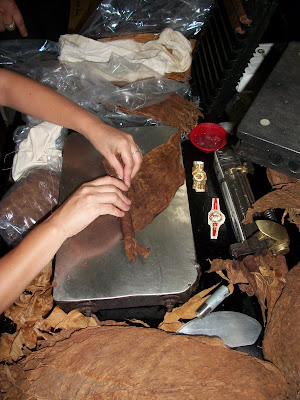Santa Rosa is the center of the Honduran cigar industry, and so Friday morning, we headed down the Flor de Copan cigar factory for a factory tour to learn a little more before our evening smoking event. The tobacco leaves are first brought in (mostly from Honduras but also imported from other countries like Nicaragua and the Dominican Republic) and allowed to ferment in big piles for at least 8 months. The fumes were so strong in the fermenting room it made our eyes water and we had to wear face masks. After that, the vein is pulled out by hand, and the leaves are sorted by size and placed in an oven to dry. Once dried, the leaves are aged from 6 months to several years to give them varying flavors. When rolling the cigars, they combine tobacco that has been aged for different lengths of time to create the correct flavor that is desired for that particular brand. The rollers roll the filler tobacco and place it in a press for 30 minutes to make the shape stick. After that, another person takes it and rolls it in the wrapper tobacco. The wrapper tobacco is often a different type of tobacco, is sometimes dyed to change its color, and is always a nicer leaf without defects. The wrapper leaves are deveined with a machine to be more precise and to keep them intact. The wrapper is also not dried, so it will stretch around the cigar without ripping. The workers add just a little bit of a gummy glue to secure the wrapper, but not much is holding it together. Once the wrapper is on, the cigars are banded and boxed. The Flor de Copan factory can make 50,000 cigars daily!
Seeing hundreds of people hand rolling cigars really gives you the feeling of being in Central American country. It is really amazing how fast they can roll the tobacco and form it into a cigar. The factory looks like a Cuban cigar factory in any movie you’ve ever seen, rows and rows of women and men in aprons doing repetitive manual labor. The good part is that people make minimum wage and the rollers get paid by the cigar so they earn a decent living. And it wasn’t really hot in there either. Flor de Copan is the leading cigar manufacturer in Honduras and makes 30-40 different brands. The Honduran cigar industry got a boost when the US imposed sanctions against Cuba, and is now considered to produce some of the best cigars in the world. Flor de Copan’s top product, Romeo y Julieta, is a cigar that is only produced there, in Cuba and the Republica Dominicana. Of course, those cigars are not sold in Honduras because they cost too much, all the stock is exported to the US.
For lunch, we went to one of the feria grounds. There were a few fair type booths with candy and games and Ferris wheels, including a hand-cranked one for little kids, but most of it was Honduran food booths. This means that there was actually some good food, not your typical fair food. We had pupusas and tajadas con carne (fried slices of platano with chicken and beef). Both were very good. We spent a bit of time there with our friend playing Scrabble Slam before we had to go back to the hotel to get ready for the main event.
While there were more things going on the following days, the premier event of Santa Rosa’s feria is the Noche de Fumadores (Night of Smokers). It is a more formal event to celebrate the cigar industry in Santa Rosa. It is also a relatively costly event, 600 lempira per couple. Despite this, there were 75 Peace Corps volunteers there, out of 360 people total. Included in your entrance cost were appetizers and unlimited drinks, as well as pretty much all the cigars you wanted. Each person was given a gift bag when entering that contained coffee and five puro cigars from Flor de Copan in a fancy box worth at least the entrance cost. Those five cigars were intended more as take home cigars. To smoke, there was a woman rolling fresh cigars, as well as a table with piles of different type of cigars from the factory for you to try. Being that there were so many volunteers there, it felt almost like a Peace Corps event. We had fun hanging out with our friends, seeing people we hadn’t seen for months, drinking some 23 year old aged rum, and trying to learn the art of smoking cigars. One of our good friends is a cigar aficionado and he patiently schooled us in cutting, lighting and ash dropping and tried to teach us how to make smoke rings, which we never quite could do. Of course, because we aren’t smokers, we were feeling a little sick at the end of the night after spending hours in a room full of smoke. After one cigar each, we were done. We were ready to leave around midnight, so we got a jalon to our hotel with another of our friends. Just as we were leaving though, they started the raffle, and I won a box of chocolate lollipops, which was a nice end to the night.
Nolan and Jose
Nicki and Harrison
Nicki and Carrie
The next day, Nicki got up early to leave for Ojojona, where she was going to help translate for a medical brigade. There will be another blog entry about that soon. I had a more relaxed morning, eating breakfast with some friends before heading home to prepare for my Peace Corps Reconnect, also another blog entry for another day.








Informative read about the art of cigar smoking,Cigar smoking has long been thought of a luxurious activity for the rich and famous.
ReplyDelete